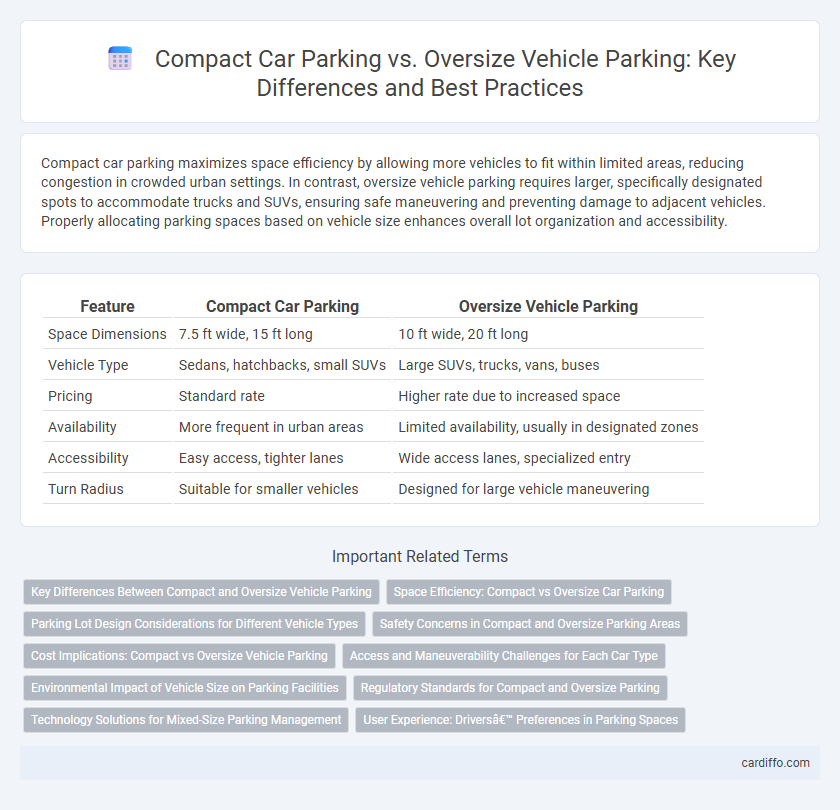Compact car parking maximizes space efficiency by allowing more vehicles to fit within limited areas, reducing congestion in crowded urban settings. In contrast, oversize vehicle parking requires larger, specifically designated spots to accommodate trucks and SUVs, ensuring safe maneuvering and preventing damage to adjacent vehicles. Properly allocating parking spaces based on vehicle size enhances overall lot organization and accessibility.
Table of Comparison
| Feature | Compact Car Parking | Oversize Vehicle Parking |
|---|---|---|
| Space Dimensions | 7.5 ft wide, 15 ft long | 10 ft wide, 20 ft long |
| Vehicle Type | Sedans, hatchbacks, small SUVs | Large SUVs, trucks, vans, buses |
| Pricing | Standard rate | Higher rate due to increased space |
| Availability | More frequent in urban areas | Limited availability, usually in designated zones |
| Accessibility | Easy access, tighter lanes | Wide access lanes, specialized entry |
| Turn Radius | Suitable for smaller vehicles | Designed for large vehicle maneuvering |
Key Differences Between Compact and Oversize Vehicle Parking
Compact car parking spaces are designed with dimensions typically around 7 to 8 feet wide and 15 to 18 feet long, optimized for small to mid-sized vehicles. Oversize vehicle parking areas provide larger dimensions, often exceeding 10 feet wide and 20 feet long, to accommodate trucks, SUVs, and vans that require additional maneuvering space. The key differences lie in size specifications, maneuverability requirements, and space allocation, directly impacting parking lot design and vehicle accessibility.
Space Efficiency: Compact vs Oversize Car Parking
Compact car parking maximizes space efficiency by allowing more vehicles to fit within a given area due to smaller stall dimensions, typically ranging from 7.5 to 8 feet wide and 15 to 16 feet long. Oversize vehicle parking requires significantly larger spaces, often exceeding 9 feet in width and 20 feet in length, leading to lower overall vehicle density and increased land use. Optimizing parking layouts with dedicated compact car zones enhances capacity and reduces congestion in urban and commercial parking facilities.
Parking Lot Design Considerations for Different Vehicle Types
Designing parking lots requires careful consideration of vehicle dimensions, accommodating compact cars with narrower and shorter spaces to maximize capacity, while oversize vehicle parking demands wider, longer stalls to ensure safety and ease of maneuvering. Properly differentiated parking layouts reduce congestion and improve traffic flow by aligning stall sizes and aisle widths with specific vehicle types. Integrating clear signage and durable pavement markings tailored for compact and oversize vehicles enhances user experience and optimizes spatial efficiency in diverse parking environments.
Safety Concerns in Compact and Oversize Parking Areas
Safety concerns in compact car parking areas often arise from limited maneuvering space, increasing the risk of minor collisions and door dings. Oversize vehicle parking zones present hazards such as reduced visibility for drivers and potential obstruction of pedestrian pathways, heightening accident risks. Implementing clear signage, adequate lighting, and designated safety buffers enhances security for both compact and oversize vehicle parking environments.
Cost Implications: Compact vs Oversize Vehicle Parking
Compact car parking spaces typically require less physical area and lower maintenance costs compared to oversize vehicle parking spots, leading to reduced overall expenses for property managers. Oversize vehicle parking demands reinforced infrastructure, increased space allocation, and higher maintenance, resulting in significantly greater cost implications. Efficient allocation and pricing strategies for compact versus oversize vehicle parking can optimize revenue streams while balancing operational expenditures.
Access and Maneuverability Challenges for Each Car Type
Compact car parking offers easier access and greater maneuverability due to smaller dimensions, allowing for tighter parking spaces and simpler navigation in crowded lots. Oversize vehicle parking presents significant challenges, requiring larger spaces and wider drive aisles to accommodate extended length and width, which complicates turning radii and increases the risk of obstruction. Design considerations for oversize vehicle parking must prioritize clear signage, ample clearance, and reduced congestion to enhance safety and accessibility.
Environmental Impact of Vehicle Size on Parking Facilities
Compact car parking requires less space and reduces the total paved area, minimizing impervious surfaces that contribute to stormwater runoff and urban heat islands. Oversize vehicle parking spaces occupy significantly more land, leading to increased resource consumption for construction and maintenance, as well as higher emissions from extended driving distances within parking facilities. Efficient allocation of compact car spots enhances land use sustainability and lowers the environmental footprint of parking infrastructure.
Regulatory Standards for Compact and Oversize Parking
Regulatory standards mandate specific dimensions for compact car parking spaces, typically measuring 7.5 to 8 feet in width and 15 to 18 feet in length, to maximize lot efficiency while ensuring safe vehicle accommodation. Oversize vehicle parking must comply with guidelines that provide wider and longer spaces, often exceeding 10 feet in width and 20 feet in length, designed to accommodate trucks, vans, and SUVs, reducing congestion and minimizing vehicle damage risks. Compliance with these regulatory standards is essential for urban planners and property developers to optimize parking facility design and meet local zoning laws effectively.
Technology Solutions for Mixed-Size Parking Management
Advanced sensor technology and AI-powered systems enable efficient mixed-size parking management by accurately detecting and allocating spaces for both compact cars and oversize vehicles. Smart parking solutions integrate real-time data analytics to optimize space utilization, reduce congestion, and provide dynamic pricing tailored to vehicle size. Mobile apps equipped with reservation features and digital signage guide drivers to appropriate spots, enhancing convenience and operational efficiency in diverse parking environments.
User Experience: Drivers’ Preferences in Parking Spaces
Drivers consistently prefer compact car parking spaces for their ease of access and maneuverability, reducing the stress of tight turns and limited space. Oversize vehicle parking, while necessary for trucks and SUVs, often requires larger, more secluded areas that can prolong the search time and complicate navigation. User experience improves significantly when parking designs clearly differentiate space sizes, aligning with driver preferences and vehicle dimensions for efficient, hassle-free parking.
Compact car parking vs Oversize vehicle parking Infographic

 cardiffo.com
cardiffo.com